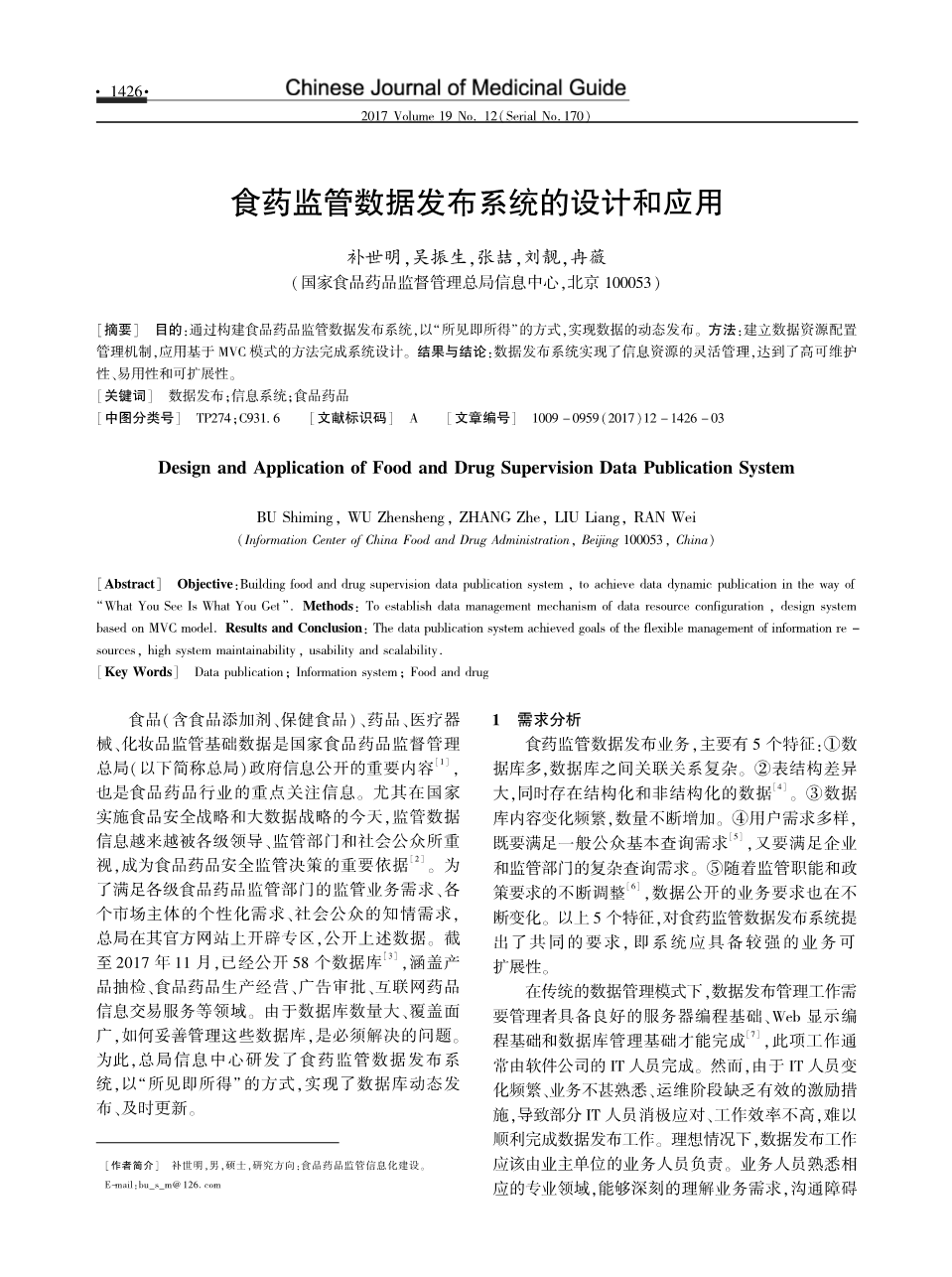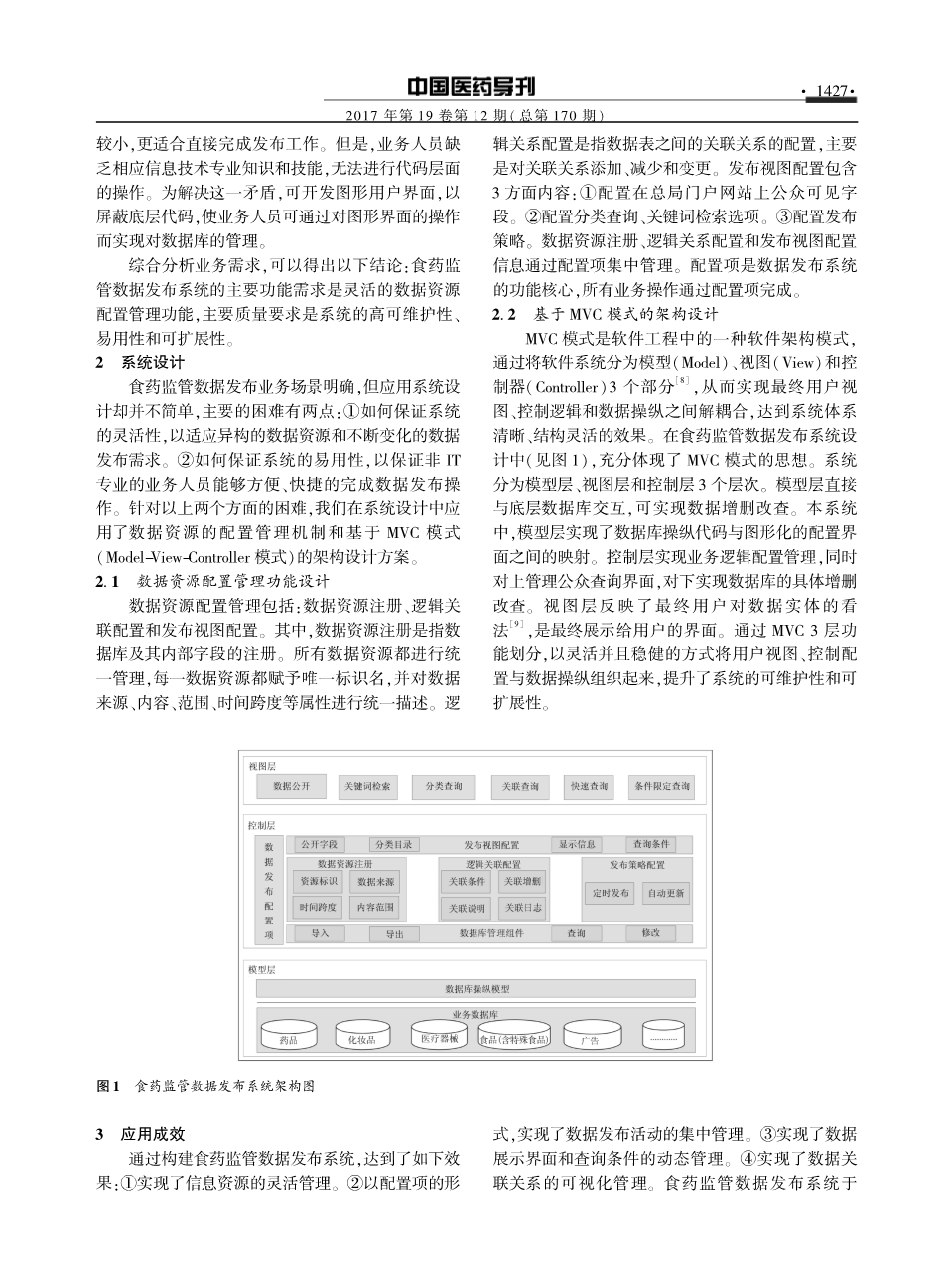

英语原文共 3 页,剩余内容已隐藏,支付完成后下载完整资料
Design and Application of Food and Drug Supervision Data Publication System
BU Shiming, WU Zhensheng, ZHANG Zhe, LIU Liang, RAN Wei
Information Center of China Food and Drug Administration, Beijing 100053, China
[Abstract] Objective:Building food and drug supervision data publication system, to achieve data dynamic publication in the way of “What You See Is What You Get ”. Methods: To establish data management mechanism of data resource configuration, design system based on MVC model. Results and Conclusion:The data publication system achieved goals of the flexible management of information re – sources, high system maintainability, usability and scalability.
[Key Words] Data publication; Information system; Food and drug
The basic data of food (including food additives, health food), medicines, medical equipment and cosmetics supervision is an important part of the government information disclosure of the State Food and Drug Administration (hereinafter referred to as the General Administration of the Peoples Republic of China), and is also the key concern of the food and drug industry. Especially in the countrys implementation of food safety strategy and big data strategy, regulatory data information is increasingly valued by leaders at all levels, regulatory authorities and the public, and has become an important basis for food and drug safety regulatory decision-making. In order to meet the regulatory business needs of food and drug regulatory authorities at all levels, the individualized needs of various market entities, and the informed needs of the public, the General Administration has opened a special area on its official website to disclose the above data. As of November 2017, 58 databases have been published, covering product sampling, food and drug production and operation, advertising approval, and Internet drug information trading services. Due to the large number of databases and wide coverage, how to properly manage these databases is a problem that must be solved. To this end, the Information Center of the General Administration of the Peoples Republic of China has developed a food and drug regulatory data release system to realize the dynamic release and timely update of the database in a “what you see is what you get” approach.
1 Demand Analysis
There are five main characteristics of the drug regulatory data release business: 1 There are many databases, and the relationship between databases is complex. 2 Table structure is very different, and there are both structured and unstructured data. 3 database content changes frequently, and the number is increasing. 4 Users have diverse needs, both to meet the general public basic query needs, but also to meet the complex query needs of enterprises and regulatory authorities. 5 As regulatory functions and policy requirements continue to adjust, the business requirements for data disclosure are constantly changing. The above five characteristics put forward a common requirement for the food and drug regulatory data release system, that is, the system should have strong business scalability.
In the traditional data management mode, the data release management work requires the administrator to have a good server programming foundation, Web display programming foundation and database management foundation to complete. This work is usually done by the software companys IT staff. However, due to frequent changes in IT staff, unfamiliar business, and lack of effective incentives during the operation and maintenance phase, some IT personnel are passively responding and work inefficient, making it difficult to successfully complete data release. Ideally, the data release should be the responsibility of the business unit of the owner. The business personnel are familiar with the corresponding professional fields, can deeply understand the business needs, have less communication barriers, and are more suitable for directly completing the release work. However, business people lack the appropriate information technology expertise and skills to perform code-level operations. To solve this contradiction, a graphical user interface can be developed to shield the underlying code so that business people can manage the database by manipulating the graphical interface.
Comprehensive analysis of business needs can lead to the following conclusions: The main functional requirements of the food regulatory data release system are flexible data resource configuration management functions. The main quality requirements are the systems high maintainability, ease of use and scalability.
2 System Design
The drug regulatory data release business scenario is clear, but the application system design is not simple. The main difficulties are twofold: 1 How to ensure the flexibility of the system to adapt to heterogeneous data resources and changing data release requirements. 2 How to ensure the ease of use of the system to ensure that non-IT professional business personnel can easily and quickly complete the data release operation
Work. In view of the above two difficulties, we applied the data resource configuration management mechanism and the MVC-based model in the system design.
2.1 Design of the Function of data Configuration Management
Data resource configuration management includes: data resource registration, logical association configuration, and release view configuration. Among them, data resource registration refers to the registration of the database and its internal fields. All data resources are managed in a unified manner. Each data resource is given a unique identifier name, and attributes such as data source, content, scope, and time span are uniformly described. Logical relationship configuration refers to the configuration of associations betw
剩余内容已隐藏,支付完成后下载完整资料
资料编号:[19898],资料为PDF文档或Word文档,PDF文档可免费转换为Word


